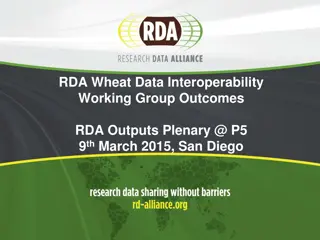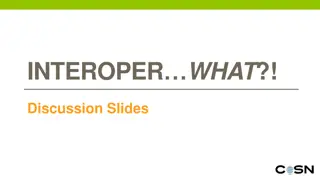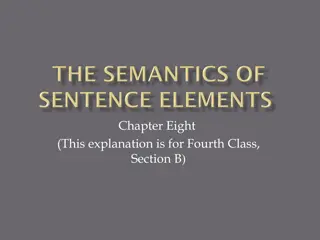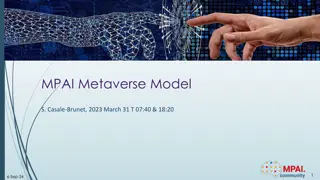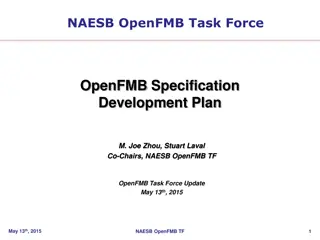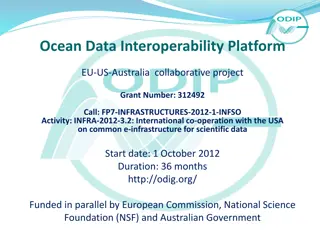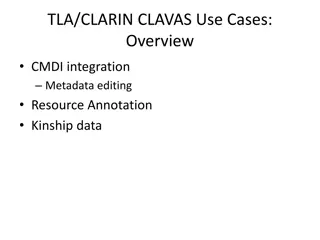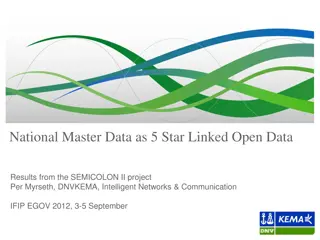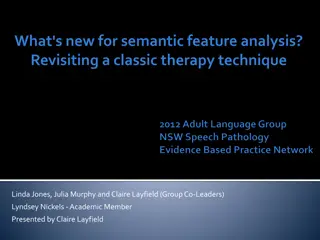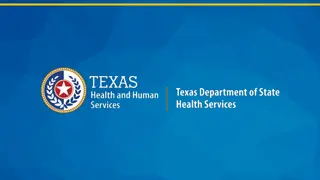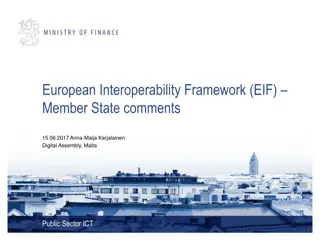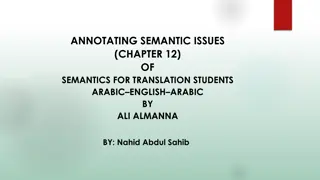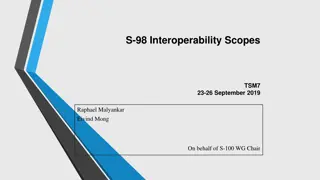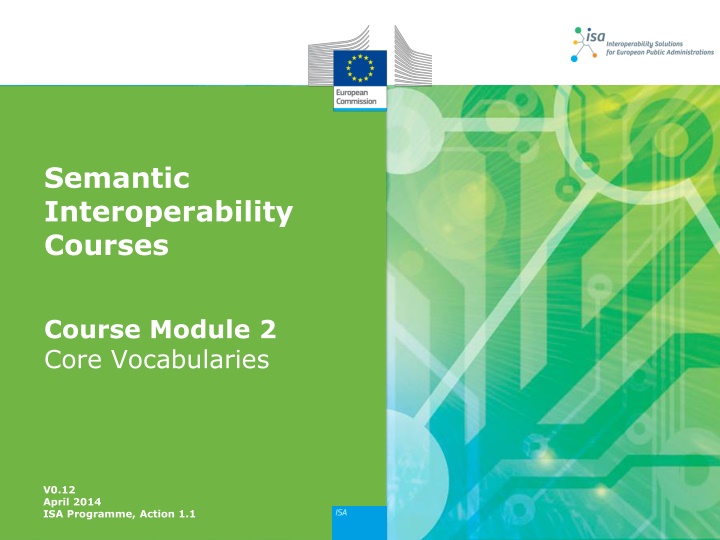
Core Vocabularies for Semantic Interoperability
Explore the significance of Core Vocabularies in achieving semantic interoperability for European Public Services. Learn about the definitions, use cases, and methodologies for leveraging Core Vocabularies to harmonize data models effectively.
Download Presentation

Please find below an Image/Link to download the presentation.
The content on the website is provided AS IS for your information and personal use only. It may not be sold, licensed, or shared on other websites without obtaining consent from the author. If you encounter any issues during the download, it is possible that the publisher has removed the file from their server.
You are allowed to download the files provided on this website for personal or commercial use, subject to the condition that they are used lawfully. All files are the property of their respective owners.
The content on the website is provided AS IS for your information and personal use only. It may not be sold, licensed, or shared on other websites without obtaining consent from the author.
E N D
Presentation Transcript
image Semantic Interoperability Courses Course Module 2 Core Vocabularies V0.12 April 2014 ISA Programme, Action 1.1
Disclaimer This training material was prepared for the ISA programme of the European Commission by PwC EU Services. The views expressed in this training material are purely those of the authors and may not, in any circumstances, be interpreted as stating an official position of the European Commission. The European Commission does not guarantee the accuracy of the information included in this study, nor does it accept any responsibility for any use thereof. Reference herein to any specific products, specifications, process, or service by trade name, trademark, manufacturer, or otherwise, does not necessarily constitute or imply its endorsement, recommendation, or favouring by the European Commission. All care has been taken by the author to ensure that s/he has obtained, where necessary, permission to use any parts of manuscripts including illustrations, maps, and graphs, on which intellectual property rights already exist from the titular holder(s) of such rights or from her/his or their legal representative. image C:\Users\goederts\Documents\projects\DIGIT-SEMIC4\branding\semic.emf SEMIC SEMANTIC INTEROPERABILITY COMMUNITY 2
Learning Objectives Understand what Core Vocabularies are. Understand how to extend the Core Vocabularies depending on your patterns of information exchange Understand how to use and extend the Core Vocabularies in your own data models. 3
Outline 1. What? - Introduction Definition: Core Vocabularies Levels of abstraction: core, domain, information exchange Overview of existing Core Vocabularies Process and methodology for developing Core Vocabularies 2. Why use the Core Vocabularies? Attain a minimum level of cross-domain semantic interoperability Patterns of information exchange Contexts of use 3. How to use the Core Vocabularies: Linked Data Extending the Core Vocabularies to publish Linked Data Best practices for publishing Linked Data Example: Describe organisations in RDF using standard Vocabularies 4. How to create e-Document formats using the Core Vocabularies Guidelines for e-Document engineering using the Core Vocabularies Example: Business Activity Registration 4
Business need The need for harmonising data models. The exchange of information in the context of European Public Services is challenging and comes with many semantic interoperability conflicts. Such interoperability conflicts are caused by discrepancies in the interpretation of administrative procedures and legislation, the lack of commonly agreed data models, the absence of universal reference data, etc. Source: eGovernment Core Vocabularies by Vassilios Peristeras, February 2012 5
Definition What is a Core Vocabulary? Simplified, re-usable, and extensible data models that capture the fundamental characteristics of a data entity in a context-neutral fashion. CORE PUBLIC SERVICE CorePerson_logo.png core_location_logo.png REGISTERED ORGANIZATION VOCABULARY VOCABULARY European Commission ISA Programme, 2014 (1) Source: https://joinup.ec.europa.eu/node/43160 6
Four Core Vocabularies CorePerson_logo.png Fundamental characteristics of a person. REGISTERED ORGANIZATION Fundamental characteristics of a legal entity, such as legal identifier, name, company type, activities. VOCABULARY core_location_logo.png Fundamental characteristics of a location, represented as an address, a geographic name, or a geometry. CORE PUBLIC SERVICE Fundamental characteristics of a public service. VOCABULARY 7
Three representation techniques The same meaning expressed in UML, RDFS, and XSD. XML schema Conceptual model Reuse existing concepts in CCL, INSPIRE, etc. RDF schema Reuses existing RDF vocabularies xml Reuses Core Components Technical Specification (CCTS) and UBL NDR ISA Open Metadata Licence v1.1 Registered Organisations Vocabulary Maintained by W3C (Government Linked Data Working Group) 8
Developed according to an open and inclusive process Process for developing Core Vocabularies 1. Identify stakeholders 2. Form Working Group 3. Identify chair/co- chairs 5. Form Review Group 4. Identify editor(s) 10. Publish the Latest Call Working Draft of the vocabulary and contact the Review Group, seeking its feedback 7. Establish a working environment and culture 6. Secure IPR 8. Publish drafts 9. Process comments 12. Gather evidence of acceptance by the potential users of the vocabulary 13. The EC to submit documents to the TIE Cluster or ISA Coordination Group 11. Review Last Call Working Draft Download the process and methodology for developing Core Vocabularies here: https://joinup.ec.europa.eu/node/43160 9
Developed according to an open and inclusive process Methodology for developing Core Vocabularies (1) 1. Identify the Core Vocabularies likely to meet the needs of potential users within European institutions 2. Working Group to research existing vocabularies (provenance, usage, stability) 3. Research existing published data and services, avoiding any conflicts with proposed Core Vocabulary 4. Articulate the problem(s) that the WG is trying to solve in the form of a series of use cases 8. Do not impose cardinality rules or domain/range restrictions on vocabulary terms unless necessary 6. Publish the use cases and requirements in a single document 5. Derive a set of requirements from the use cases 7. Create a concept diagram (UML) 9. Use words beginning with an upper or lower case letter or an underscore for all terms in a vocabulary 12. For each relationship, include a definition of its inverse 10. Use simple nouns for property names 11. Use verbs for relationship terms Download the process and methodology for developing Core Vocabularies here: https://joinup.ec.europa.eu/node/43160 10
Developed according to an open and inclusive process Methodology for developing Core Vocabularies (2) 16. Include a portion that identifies the vocabulary for human readers 13. Use prepositions in vocabulary terms only if necessary 14. Use a namespace ending with a hash character (#) 15. Keep the namespace as short as possible 18. Do notrestrict pool of potential users by using a namespace declaring ownership or geographical relevance 17. Do not include any technology- specific component in the namespace (except HTTP) 20. Create and validate the namespace documents in HTML, XML and RDF/XML. 19. If necessary, consider meeting step 18 using PURLs 21. Either the WG or the EC must make each one available through {namespace}.ext 22. Either the WG or the EC must set up content negotiation to handle requests to the namespace itself 23. When publishing the final version of the Core Vocabulary, link the HTML document to an errata document 24. Include a Conformance Statement Download the process and methodology for developing Core Vocabularies here: https://joinup.ec.europa.eu/node/43160 11
Reuse by extension Extend the Core Vocabularies into domain models and information exchange models Core model:a context-neutral data model that captures the fundamental characteristics of an entity. Domain model: a conceptual view of a domain that identifies the entities involved and their relationships Information exchange model: a model that defines and describes the structure and content of a specific information exchange context. Core models Domain models Information exchange models 12
Reuse by extension Extend the Core Vocabularies into domain models and specifications for information exchange Domain model:Health Domain model: Procurement Information exchange model: Patient Summary Information exchange model: Tender Domain model: Tax Domain model: Customs Information exchange model: Tax Declaration Information exchange model: Freight Document 13
Reuse by extension Extend the Core Vocabularies into domain models and specifications for information exchange Representation techniques UML model RDFS /OWL XML xml Schema Information exchange Linked Data, e-Documents (?) Information exchange e-Documents Levels of abstraction domain models domain vocabularies domain schemas Domain Core Vocabularies Core 14
Outline 1. What? - Introduction Definition: Core Vocabularies Levels of abstraction: core, domain, information exchange Overview of existing Core Vocabularies Process and methodology for developing Core Vocabularies 2. Why use the Core Vocabularies? Attain a minimum level of cross-domain semantic interoperability Patterns of information exchange Contexts of use 3. How to use the Core Vocabularies: Linked Data Extending the Core Vocabularies to publish Linked Data Best practices for publishing Linked Data Example: Describe organisations in RDF using standard Vocabularies 4. How to create e-Document formats using the Core Vocabularies Guidelines for e-Document engineering using the Core Vocabularies Example: Business Activity Registration 15
Why use the Core Vocabularies? To attain a minimum level of cross-domain semantic interoperability The compliance of characteristics to Core Vocabulary specifications guarantees a minimum of cross-domain interoperability, while providing domain-specific communities Core Vocabularies offer freedom and a common starting point for drafting specializations of one s own by adding metadata to the Core Increase the possibilities for reuse Avoid schema-level conflicts, which are caused by a different logical structure or inconsistencies in metadata Source: eGovernment Core Vocabularies by Vassilios Peristeras, February 2012 16
Why use the Core Vocabularies? To avoid schema-level conflicts Examples of schema-level conflicts: Entity identifier Schema isomorphism Schematic discrepancies Naming Generalization Aggregation Citizen information is verified against the wrong source* Citizens identified by ID card number or national number or none? Different attributes on ID cards in different states Birth certificate of one state can contain all info of birth and family certificates of another state full name or surname ; middle name ; first name Detailed Information cannot be exchanged due to schematic differences (ex. different xml schemas) * Naming conflicts: evidence placeholders with the same name but different purpose and usage may exist in different Member States, or evidence placeholders with different names may have similar usage and hold similar evidence items. More on semantic conflicts: V. Peristeras - A conceptual analysis of semantic conflicts in pan-European e-government services 17
Contexts in which the Core Vocabularies can be used Development of new systems: the Core Vocabularies can be used as a default starting point for designing the conceptual and logical data models in newly developed information systems. Information exchange between systems: the Core Vocabularies can become the basis of a context specific data model used to exchange data among existing information systems. Data integration: the Core Vocabularies can be used to integrate data that comes from disparate data sources and create a data mesh-up. Open data publishing: the Core Vocabularies can be used as the foundation of a common export format for data in base registries like cadastres, business registers and service portals. 18
Outline 1. What? - Introduction Definition: Core Vocabularies Levels of abstraction: core, domain, information exchange Overview of existing Core Vocabularies Process and methodology for developing Core Vocabularies 2. Why use the Core Vocabularies? Attain a minimum level of cross-domain semantic interoperability Patterns of information exchange Contexts of use 3. How to use the Core Vocabularies: Linked Data Extending the Core Vocabularies to publish Linked Data Best practices for publishing Linked Data Example: Describe organisations in RDF using standard Vocabularies 4. How to create e-Document formats using the Core Vocabularies Guidelines for e-Document engineering using the Core Vocabularies Example: Business Activity Registration 19
What is linked data? Linked data is a set of design principles for sharing machine- readable data on the Web The four design principles of Linked Data (by Tim Berners Lee): 1. Use Uniform Resource Identifiers (URIs) as names for things. 2. Use HTTP URIs so that people can look up those names. 3. When someone looks up a URI, provide useful information, using the standards (RDF, SPARQL). 4. Include links to other URIs so that they can discover more things. 20
Linked Data: Best Practices Use and extend the Core Vocabularies to publish Linked Data 1. Prepare stakeholders 4. Specify an appropriate licence 2. Select a dataset 3. Model the data 5. Good URIs for Linked Data 6. Use standard vocabularies 8. Provide machine access to data 7. Convert data 9. Announce new datasets 10. Recognize the social contract core_vocabularies_logo.png Source: http://www.w3.org/TR/ld-bp/ 21
The Core Vocabularies abide by the Linked Data principles ISA s Core Person, Core Location and Core Business Vocabularies have been taken as inputs by the Government Linked Data Working Group (GLD WG) of W3C. Core Vocabularies: o promote the use of common identifiers for organisations, people and locations in the form of URIs. o can be easily combined with other Linked Data vocabularies. o can easily be extended with new classes and attributes to fulfil new domain requirements. 22
Example: Describe organisations in RDF using standard Vocabularies Organisations can be described in RDF using a combination of the Registered Organization Vocabulary and the more general Organization Ontology. o Registered Organization Vocabulary: simplified, reusable and extensible data model; describes organisations that have gained legal entity status through a formal registration process (Registered Organizations - RegORG) o Organization Ontology (ORG): describes the several parts of an organisation. Case example: PricewaterhouseCoopers Enterprise Advisory is a registered legal entity in the Belgian company register. Source: https://joinup.ec.europa.eu/node/52998/ 23
REGISTERED ORGANIZATION VOCABULARY Example: Describe organisations in RDF using standard Vocabularies Registered Organization Vocabulary Describe essential elements of a registered organisation Data fields in official extracts of business registers o the legal name of the organisation o the registered number of the organisation o the legal address of the organisation o the activities for which the organisation is registered for o the type of organisation Each organisation is identified by a unique URI Source: https://joinup.ec.europa.eu/node/52998/ 24
REGISTERED ORGANIZATION VOCABULARY Example: Describe organisations in RDF using standard Vocabularies Registered Organization Vocabulary: PricewaterhouseCoopers Enterprise Advisory Legal name <rov:Registeredorganisation rdf:about= http://kbopub.economie.fgov.be/kbopub/ toonondernemingps.html?ondernemin
gs nummer=415622333 > <rov:legalName>PricewaterhouseCoopers Enterprise Advisory</rov:legalName> </rov:Registeredorganisation> Registered number <rov:registration> <adms:Identifier rdf:about="http://example.com/Reg415622333"> <skos:notation>0415.622.333</skos:notation> <adms:schemeAgency>Belgian Base Register for Companies</adms:schemeAgency> </adms:Identifier> </rov:registration> Type <rov:companyType> <skos:Concept rdf:about="http://example.com/Cooperatievevennoot schap"> <rdfs:label>Cooperatieve vennootshap</rdfs:label> </skos:Concept> </rov:companyType> <rov:registeredAddress> <locn:Address rdf:about="http://example.com/ra415622333"> <locn:postCode>1932 Zaventem</locn:postCode> <locn:fullAddress>Belgium, Woluwedal 18</locn:fullAddress> </locn:Address> </rov:registeredAddress> Activities for which the company is registered for <skos:Concept rdf:about="http://example.com/ca7022"> <rdfs:label>Business and other management consultancy activities</rdfs:label> </skos:Concept> <skos:Concept rdf:about="http://example.com/ca74142"> <rdfs:label>Other business and management consultancy activities</rdfs:label> </skos:Concept> Legal address Source: https://joinup.ec.europa.eu/node/52998/ 25
Outline 1. What? - Introduction Definition: Core Vocabularies Levels of abstraction: core, domain, information exchange Overview of existing Core Vocabularies Process and methodology for developing Core Vocabularies 2. Why use the Core Vocabularies? Attain a minimum level of cross-domain semantic interoperability Patterns of information exchange Contexts of use 3. How to use the Core Vocabularies: Linked Data Extending the Core Vocabularies to publish Linked Data Best practices for publishing Linked Data Example: Describe organisations in RDF using standard Vocabularies 4. How to create e-Document formats using the Core Vocabularies Guidelines for e-Document engineering using the Core Vocabularies Example: Business Activity Registration 26
e-Document formats Extending the Core Vocabularies Definitions: e-Document:any document in electronic format containing structured data (and possibly also unstructured data) used in the context of an administrative process. e-Document format: is a specification that lays down the syntax (structure) and semantics of a particular type of e- Document. The Core Vocabularies can be used as a starting point to define e-Document formats 27
Example: Business activity registration (Point of Single Contact) Acceptance Use the Core Vocabularies (i.e. Registered Organization Vocabulary) as a starting point for the e-Document Business Activity Registration Request Applicant Apply for Activity Registration Rejection Issue Licence Public administration (Back Office) Investigate Activity Registration Business Activity Registration Request Reject Licence 28
Methodology for e-Document engineering Context & Requirements Semantics Behaviour Syntax 4. Syntax binding 3. Business rules definition 1.Requirement Gathering 2. Information modelling 5. Schema production The decision to use (and extend) the Core Vocabularies is taken in these steps D1.2 - Guidelines on e-Document engineering for public administrations 29
Physical Model (PSM) Syntax Conceptual Model (CIM) Semantics Logical Model (PIM) Behaviour Context & Requirements 1. Requirement gathering 4. Syntax binding 1. 2. 3. Business rules definition Requirement Gathering Information modelling 5. Schema production The first step is to precisely define the objective of the business process. Goals: describe specific goals to be achieved with the exchange of e-Documents Scope: describe the scope derived from the goals Key examples: describe key examples as real-life scenarios to depict the business process flow Specific requirements: gather specific requirements that e- Documents must fulfil linked to the goals 30
Physical Model (PSM) Syntax Conceptual Model (CIM) Semantics Logical Model (PIM) Behaviour Context & Requirements 1. Requirement gathering Example: business activity registration 4. Syntax binding 1. 2. 3. Business rules definition Requirement Gathering Information modelling 5. Schema production Goals Goal ID Goal Name Goal Description Improve Business Process Performance To simplify the business activity registration procedure both for the businesses and competent authorities G1 Improve Management Efficacy To harmonize the business activity registration both at European level and at national level. G2 Decrease Costs and save time To enable competent authorities to check for validity and suitability of the information and supporting documents submitted by the businesses. G3 G4 Improve Security To increase the security and reliability of the business activity registration transactions 31
Physical Model (PSM) Syntax Conceptual Model (CIM) Semantics Logical Model (PIM) Behaviour Context & Requirements 1. Requirement gathering Example: business activity registration 4. Syntax binding 1. 2. 3. Business rules definition Requirement Gathering Information modelling 5. Schema production Scope Scope statement A user accesses a website to get information on the documents that have to be presented in a destination country (being a foreign country or their own) in order to register a business activity. The website system provides the user with information on the documents he has to upload in order to be able to submit the business activity registration request to the destination country. It is outside of the scope the process by which the website system describes the documents to be submitted. The website collects the electronic unstructured documents and metadata from the business. The website creates the e-Document with the metadata about the user, the business, the activity and the documents uploaded by the user. The website submits the e-Document instance to the destination country Point of Single Contact. The Point of Single Contact in the destination country acknowledges the business activity registration request and forwards it to the proper authority for license issuance. 32
Physical Model (PSM) Syntax Conceptual Model (CIM) Semantics Logical Model (PIM) Behaviour Context & Requirements 1. Requirement gathering Example: business activity registration 4. Syntax binding 1. 2. 3. Business rules definition Requirement Gathering Information modelling 5. Schema production Key example Key Example Identifier Key Example Description A French business person browses the French PSC looking for registration his business activity in Germany. The PSC website offers a page with the possible countries and activities per country he can register. The French business person picks up on obtaining a license for opening a store in Germany. The PSC website provides detailed information on the documents needed to obtain this license through a form. KE1 The French business person uses the form to upload the requested documents. The PSC website requests the French business person to log in or register in order to get information about his business. The PSC website packs all documents and submits that to the German PSC The PSC website sends back to the French business person the acknowledgement of reception from the German PSC 33
Physical Model (PSM) Syntax Conceptual Model (CIM) Semantics Logical Model (PIM) Behaviour Context & Requirements 1. Requirement gathering Example: business activity registration 4. Syntax binding 1. 2. 3. Business rules definition Requirement Gathering Information modelling 5. Schema production High level requirements Requirement identifier Requirement name Requirement statement Rationale Reference to goals The receiving PSC needs to know the business requesting the business registration activity to be able to understand which are the documents he has to receive. The business requesting the registration of the activity has to be identified Business information R1 G1, G4 The person requesting the service on behalf of the business has to be identified The receiving PSC has to ensure the requestor is capable of requesting the service on behalf of the business. R2 Requestor G4 Business activity The business activity to be registered has to be identified The receiving PSC has to know for which business activity the requester is registering for. R3 G1, G2 The provided documents have to be identified and their purpose has to be described The receiving PSC has to be able to identify unstructured documents to automate the R4 Documents G1, G2, G3 The business request has to be identified The business request has to be uniquely identifiable, with information about its issuance. R5 Identification G1, G2, G3 34
Physical Model (PSM) Syntax Conceptual Model (CIM) Semantics Logical Model (PIM) Behaviour Context & Requirements 2. Information modelling 4. Syntax binding 1. 2. 3. Business rules definition Requirement Gathering Information modelling 5. Schema production This phase identifies and describes the information to be exchanged in e-Documents according to the requirements specified in the first step. Capture business terms in an information model describing the explicit semantics of every data element: attributes and cardinalities Describe the relationships between information components and requirements Depict information model requirements using a conceptual modelling language (ISO11179 MDR) Identify and reuse semantics and concepts from standard vocabularies where possible 35
Physical Model (PSM) Syntax Conceptual Model (CIM) Semantics Logical Model (PIM) Behaviour Context & Requirements 2. Information modelling Example: business activity registration 4. Syntax binding 1. 2. 3. Business rules definition Requirement Gathering Information modelling 5. Schema production Reference to Information Requirement Identifier Business Term Name Business Requirement Identifier Business Rule Identifier Standard Concept Name Concept location Usage Cardinality Concept Description The activity of an organisation should be recorded using a controlled vocabulary. Several vocabularies exist, many of which map to the UN's ISIC codes. The preferred choice for European interoperability is NACE. Activity performed by the legal entity, which is requested for registration Registered Organization Vocabulary Business activity Organisation Activity IR4 R3 1..1 Name of the legal entity that is requesting the business activity registration The legal name of the business. A business might have more than one legal name, particularly in countries with more than one official language. Registered organisation Vocabulary Business name IR5 R1 1..1 Legal Name This property records the type of company. Familiar types are SA, PLC, LLC, GmbH etc. At the time of publication, there is no agreed set of company types that crosses borders. Each jurisdiction needs a limited set of recognized company types and these should be expressed in a consistent manner. Type of the legal entity that is requesting the business activity registration Business legal form Registered Organization Vocabulary Organisation Type IR6 R1 1..1 36
Physical Model (PSM) Syntax Conceptual Model (CIM) Semantics Logical Model (PIM) Behaviour Context & Requirements 3. Business rules definition 4. Syntax binding 1. 2. 3. Business rules definition Requirement Gathering Information modelling 5. Schema production In the previous step (information modelling) the business terms and facts were described. However, there are still action assertions, constraints and derivations concerning some aspects of the e- Document. These business rules are described according to the goals and requirements of the first step. Identify integrity constraints on the information model and describe them as business rules Define inferences and mathematical calculations that the e- Document elements must fulfil Define conditional business rules and co-occurrence constraints that e-Document elements must fulfil Define sets of allowed values for coded data elements 37
Physical Model (PSM) Syntax Conceptual Model (CIM) Semantics Logical Model (PIM) Behaviour Context & Requirements 3. Business rules definition Example: business activity registration 4. Syntax binding 1. 2. 3. Business rules definition Requirement Gathering Information modelling 5. Schema production Refer to Information Requirements Refer to High Level Requirements Business Rule ID Error level Rule BR1 The business activity must refer to a NACE activity IR4 R3 Fatal The legal form of the business must be recognized by the business' country of origin BR2 IR7 R1 Fatal 38
Physical Model (PSM) Syntax Conceptual Model (CIM) Semantics Logical Model (PIM) Behaviour Context & Requirements 4. Syntax binding (reuse) 4. Syntax binding 1. 2. 3. Business rules definition Requirement Gathering Information modelling 5. Schema production Syntax binding is one of the options to produce physical artefacts in order to help developers implement the e-Documents according to the e-Document format rules. With syntax binding, the information requirement model is mapped to an existing syntax model and the usage guidelines are specified. Map the information model to a standard syntax when this syntax fulfils most of the goals and requirements of the project Create a usage guideline on the syntax for implementers Create validation artefacts for business rules and code lists List minor gaps and/or requirements that cannot be fulfilled using the selected syntax 39
Physical Model (PSM) Syntax Conceptual Model (CIM) Semantics Logical Model (PIM) Behaviour Context & Requirements 5. Schema production (partial reuse) 4. Syntax binding 1. 2. 3. Business rules definition Requirement Gathering Information modelling 5. Schema production The second option is to produce a new e-Document format. This option should be followed when there are no recognized international standards for the industry and business process the project is targeting. Map common information model components to available Common Vocabulary schemas (e.g. ISA Core Vocabularies, UBL common library, UN/CEFACT Core Components Library) Create new e-Document formats using a standard NDR to automate the schema production Create validation artefacts for business rules and code lists 40
Physical Model (PSM) Syntax Conceptual Model (CIM) Semantics Logical Model (PIM) Behaviour Context & Requirements 5. Schema production (partial reuse) Example: business activity registration 4. Syntax binding 1. 2. 3. Business rules definition Requirement Gathering Information modelling 5. Schema production XSD Schema: BusinessActivityRegistrationRequest.xsd <?xml version="1.0" encoding="UTF-8"?> <!-- Library: Business Activity Registration Request document demonstration Module: xsd/mydoc/BusinessActivityRegistrationRequest.xsd Generated on: 2014-03-06 16:31z --> <xsd:schema xmlns="urn:X-MyCompany:xsd:MyBusinessActivityRegistrationRequest" xmlns:mya="urn:X-MyCompany:xsd:MyRARequestResponse:AggregateComponents" xmlns:myb="urn:X-MyCompany:xsd:MyRARequestResponse:BasicComponents" xmlns:cac="urn:oasis:names:specification:ubl:schema:xsd:CommonAggregateComponents-2" xmlns:cbc="urn:oasis:names:specification:ubl:schema:xsd:CommonBasicComponents-2" xmlns:ext="urn:oasis:names:specification:ubl:schema:xsd:CommonExtensionComponents-2" xmlns:xsd="http://www.w3.org/2001/XMLSchema" xmlns:ccts="urn:un:unece:uncefact:documentation:2" targetNamespace="urn:X-MyCompany:xsd:MyBusinessActivityRegistrationRequest" elementFormDefault="qualified" attributeFormDefault="unqualified" version="1"> <!-- ===== Imports ===== --> <xsd:import namespace="urn:X-MyCompany:xsd:MyRARequestResponse:AggregateComponents" schemaLocation="MyRARequestResponseAggregateComponents.xsd"/> <xsd:import namespace="urn:X-MyCompany:xsd:MyRARequestResponse:BasicComponents" schemaLocation="MyRARequestResponseBasicComponents.xsd"/> 41
e-Document engineering Tools Tool Description SemanticMDR Information Modelling Metadata Registry Schema creation UN/CEFACT NDR Schema creation X V NDR / any (configurable) Schema creation OASIS UBL NDR Metadata Workbench Xgenerator https://joinup.ec.europa.eu/software/xgenerator/description Crane Software GC-to- UBL NDR script http://www.cranesoftwrights.com/resources/ubl/index.htm# gc2ublndr eDoCreator http://srdc.com.tr/dist/#/edocreator GEFEG.FX http://www.gefeg.com/en/index.htm Enterprise Architect + ShapeChange Schema creation OASIS UBL NDR Information Modelling +Schema creation CEFACT NDR, OASIS UBL NDR, Information Modelling +Schema creation GML NDR 42
core_vocabularies_logo.png xml Illustration: Business Activity Request XML Schema CoreVocabularyBasicComponents.xsd (namespace prefix: cvc) BusinessActivityRegistrationRequest.xsd <xsd:element name= BusinessActivityRegistrationRequest type= BusinessActivityRegistrationRequestType" /> <xsd:complexType name="BusinessActivityRegistrationRequestType"> <xsd:sequence> <xsd:element maxOccurs= 1 minOccurs= 1" ref="cva:Cvbusiness" /> </xsd:sequence> </xsd:complexType> <xsd:element type= LegalNameType name= LegalName /> <xsd:complexType name= LegalNameType > <xsd:simpleContent> <xsd:extension base="udt:TextType /> </xsd:simpleContent> </xsd:complexType> CoreVocabularyAggregateComponents.xsd (namespace prefix: cva) <xsd:element name= Cvbusiness" type="CvbusinessType /> <xsd:complexType name="CvbusinessType"> <xsd:sequence> <xsd:element maxOccurs="unbounded minOccurs="0" ref="cvc:LegalName" /> </xsd:sequence> </xsd:complexType> The global elements cvc:LegalName and cva:Cvbusiness can be reused in any schema 43
References A conceptual analysis of semantic conflicts in pan-European e-government services, Peristeras, V., Loutas, N., Goudos, S. K., & Tarabanis, K., 2008, Journal of Information Science, 34(6), 877-891. Enterprise Integration Patterns, Hohpe & Woolf, 2003, Addison-Wesley Professional Best Practices for Publishing Linked Data, W3C, 2014 Describe organizations in RDF with Core Business Vocabulary and ORG Ontology, November 2012 Process and methodology for Core Vocabularies, ISA, November 2011 eGovernment Core Vocabularies by Vassilios Peristeras, February 2012 44
Project Officers Vassilios.Peristeras@ec.europa.eu Suzanne.Wigard@ec.europa.eu Athanasios.Karalopoulos@ec.europa.eu Visit our initiatives Get involved ADMS. SW ADMS_logo.png DCAT application profile for data portals in Europe logo REGISTERED ORGANIZATION http://www.deviantart.com/download/306854489/new_twitter_logo_by_ockre-d52oyft.png Follow @SEMICeu on Twitter VOCABULARY SEMIC group on LinkedIn Join the SEMIC group on LinkedIn CORE PUBLIC SERVICE core_vocabularies_logo.png core_location_logo.png CorePerson_logo.png https://joinup.ec.europa.eu/sites/default/files/ckeditor_files/images/SEMIC_Community_Logo.png Join the SEMIC community on Joinup VOCABULARY

